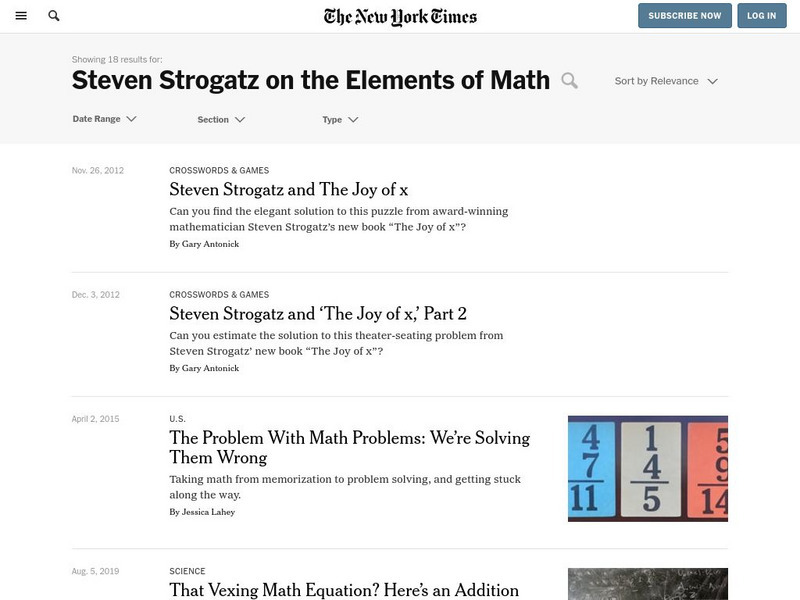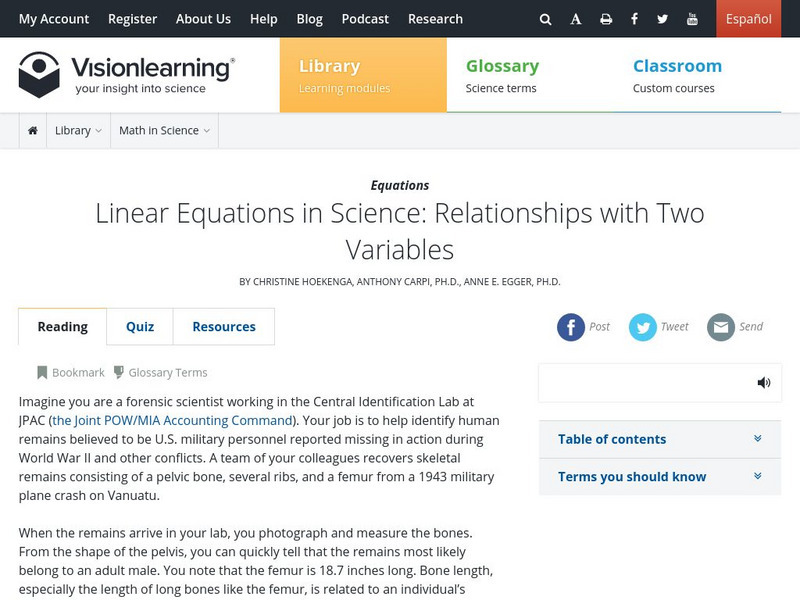Curated OER
Math in Science-Knowing the Calories You Take In!
I can burn off one scrambled egg in 30 minutes of walking? Explain how we daily consume and burn calories using this fun worksheet, which breaks down basic foods and activities into kilocalorie equivalents. Nutritionists calculate the...
Curated OER
Math in Science-Rain Forest Math
In this rain forest worksheet, students use different basic math skills to calculate the percentage of Earth covered by rain forests today compared to fifty years ago. They study the effects of how cutting down trees contributes to water...
Curated OER
Math in Science-Sound Reasoning
In this basic math skills worksheet, students use division, decimals and multiplication to calculate the speed of sound in water and compare it to the speed in air. They calculate distances sound travels in water and the time it takes...
Curated OER
Math in Science-Radioactive Decay and Half-Life
In this radioactive decay and half-life instructional activity, students use given half-lifes to calculate the amount of time it will take for certain amounts of elements to decay. They also find the age of samples and determine how many...
Curated OER
Math in Science-Using Temperature Scales
In this temperature scales worksheet, students are given the equations to convert from Fahrenheit to Celsius and from Celsius to Fahrenheit. They apply to equations and convert given temperatures.
Curated OER
Rain On
Fourth graders study the water cycle and clouds. In this water cycle and cloud lesson, 4th graders determine the definition of condensation and watch a demonstration in which the teacher makes a cloud in a bottle. They discuss the water...
Curated OER
Galaxies and the Universe
If Earth was formed 4600 million years ago, and the sun revolves about the center of the Milky Way once every 250 million years, how many revolutions have occurred? Students answer this question and ten more, all providing students with...
Houghton Mifflin Harcourt
Random Samples: Estimating Population
With this estimating populations assignment, your class will learn about taking random population samples and calculating the average number of species in the samples to estimate the total population. Students use the given data to find...
New York Times
New York Times: Steven Strogatz on the Elements of Math Series the New York Times
[Free Registration/Login Required] On this site, Cornell University mathematics professor, Steven Strogatz, shares his 15-part series of columns on the elements of math. He investigates topics ranging from negative numbers to subtraction...
Other
American Mathematical Society: Mathematical Moments
Use this resource to promote an awareness of mathematics as it occurs in nature, science, technology and human culture. This series of articles and podcasts can be used as teaching resources.
Vision Learning
Visionlearning: Exponential Equations in Science: Growth and Decay
Definition of exponential equations and an explanation of how they relate to science.
Vision Learning
Visionlearning: Linear Equations in Science: Relationships With Two Variables
An introduction to the history of linear equations and how they relate to science.
Vision Learning
Visionlearning: Exponential Equations in Science: Constant E, Limits to Growth
An introduction to exponential equations that describe growth and decay over time. Variables and constants in the equation are explained.
Vision Learning
Visionlearning: Wave Mathematics: Trigonometric Functions
Learn how to use trigonometric functions to study waves.
Vision Learning
Visionlearning: Statistics: Introduction to Inferential Statistics
An introduction to inferential statistics to find relationships and patterns in datasets.
Vision Learning
Visionlearning: Statistics: Using Mean, Median, and Standard Deviation
An introduction to recognizing trends and relationships in data through descriptive statistics.















